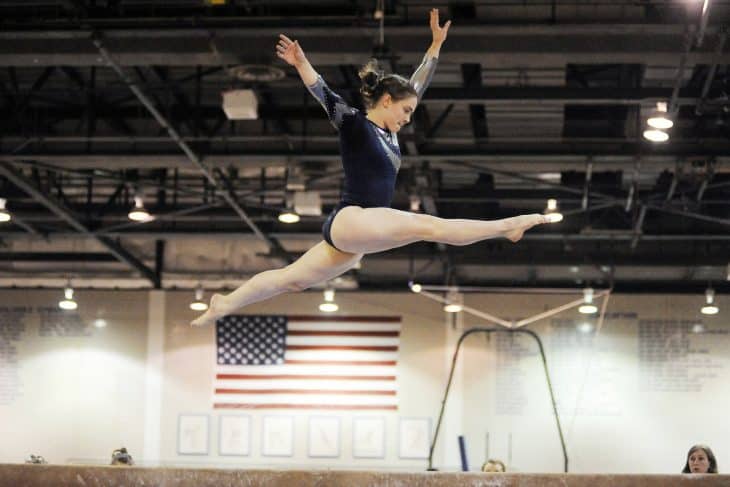
- Origin: Late 1700s
- Inventor: Friedrich Ludwig Jahn
- Birthplace: Greece, Germany
- Styles: Artistic, Rhythmic, Aesthetic, Aerobic, Trampolining, and Tumbling
- Olympic Sport: Yes
- Association: Federation of International Gymnastics (FIG)
- Men’s Apparatus: Pommel Horse, Still Rings, Vault, Parallel Bars, and High Bar
- Women’s Apparatus: Vault, Uneven Bars, and Balance Beam
- Popularity: Over 3 Million Participants in the United States
- Famous Faces: Mary Lou Retton, Kerri Strug, and Gabby Douglas
- History: Friedrich Ludwig Jahn is considered the father of modern gymnastics
- History: Gymnastics was at the 1st Olympics
- Competition: Men’s Olympic gymnastics has 6 events
- Competition: Women’s Olympic artistic gymnastics has 4 events
- Style: Only women practice rhythmic gymnastics competitively
- Olympics: Trampolining bounced into the Olympics in 2000
- Association: The Federation of International Gymnastics (FIG) is the oldest sports organization
- Rules: There’s no more Perfect 10 in gymnastics
- Rules: Gymnastics age restrictions are controversial
- Records: Mary Lou Retton won the 1st all-around gold for the US
- The first gymnasts practiced nude
- Women’s gymnastics was introduced at the 1928 Amsterdam Olympics
- The first perfect 10’s in gymnastics were in 1976
- The Soviet Union holds the most Olympic medals in gymnastics
- 111 American gymnasts competed in the 1904 Olympics
- Nadia Comăneci’s coach defected to the US during the Cold War
- Kerri Strug vaulted to gold with an injured ankle in the 1996 Olympics
- The 2004 Olympics featured twin gymnasts that won silver and gold
Gymnastics Facts Infographics
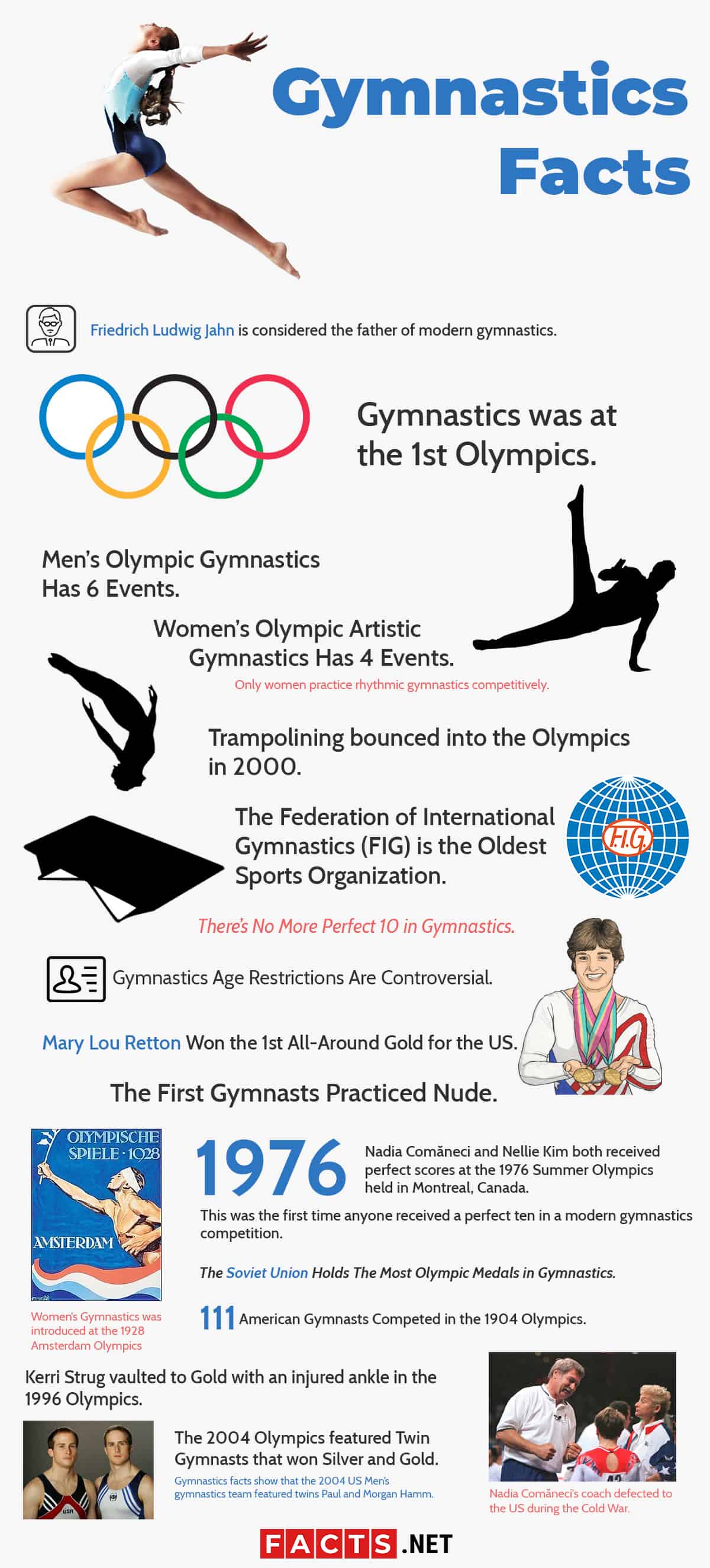
Friedrich Ludwig Jahn Is Considered the Father of Modern Gymnastics
While the ancient Greeks practiced a form of gymnastics that included stretching, swimming, and running, gymnastics facts show that modern gymnastics began in the late 1700s. Friedrich Ludwig Jahn of Germany is generally considered the father of gymnastics as he invented several pieces of apparatus, including the parallel bars and the balance beam, which are both in use today. In 1811, Jahn created a school to spread the word about gymnastics. Around this time, Guts Muth introduced more rhythmic gymnastics in Sweden. Dr. Dudley Allen Sargent is credited with bringing this sport to the United States around the time of the Civil War.
Gymnastics Was at the 1st Olympics
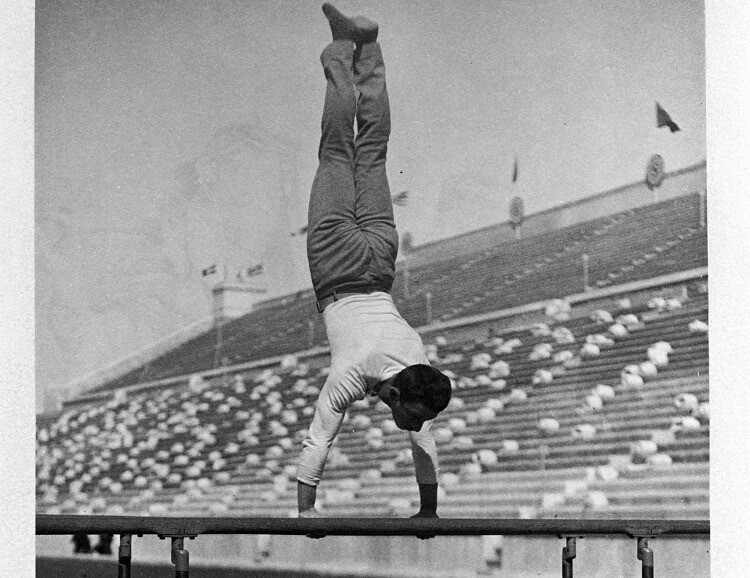
Gymnastics facts indicate that the first modern Olympics, held in 1896, included a variation of men’s gymnastics, including rope climbing. The 1924 Olympic Games in Paris were the first to feature men’s gymnastics on apparatuses. Women’s gymnastics were finally included in the 1928 Olympic Games in Amsterdam, though it wasn’t until the 1960 games in Rome that the events we commonly see in the summer Olympic games were finalized.
Men’s Olympic Gymnastics Has 6 Events
There are six events performed at the Summer Olympic Games by male artistic gymnasts. Male gymnasts focus on floor exercise, pommel horse, still rings, vault, parallel bars, and high bar. The team competition is comprised of all six events being performed by each member of a team. Gymnastics facts tell us that individual gymnasts may also medal in the all-around competition by performing well on all six apparatuses.
Women’s Olympic Artistic Gymnastics Has 4 Events
The Summer Olympic Games and international competitions feature four individual events for women in artistic gymnastics. Women compete on the vault, the uneven bars, the balance beam, and on floor exercise. Each of these forms one Olympic event. There are also two events that combine all four apparatuses. The team event requires each member of the team to perform all four. The all-around individual medal can also earned by excelling in each event.
Only Women Practice Rhythmic Gymnastics Competitively
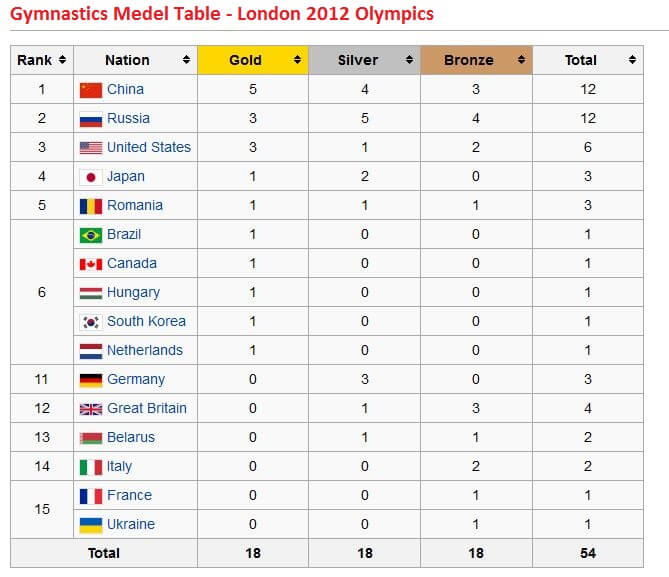
Rhythmic gymnastics was added to the Olympic Roster in 1984 and premiered at the Los Angeles Summer Olympics. At the moment, it is currently only practiced at the Olympic level by women. There are five events in rhythmic gymnastics: ball, hoop, ribbon, clubs, and rope. Gymnastics facts show that rhythmic gymnastics combines gymnastics moves with apparatus and dance to create a unique rhythmic performance that is judge by artistry, difficulty, and execution. There is no specific judgment of rhythm, though we expect you’ve got to keep a pretty good groove to score well in those other areas.
Trampolining Bounced into the Olympics in 2000
Individual trampolining was added to the roster of gymnastics events at the Olympics in 2000. Trampolining involves a series of ten jumps and aerial skills performed on a trampoline without a break. Trampolining is judged by difficulty and the length of performance. Gymnastics facts indicate that the United States has not yet won an Olympic trampolining medal. Seems like the US needs to bounce its trampolining game up a notch!
The Federation of International Gymnastics (FIG) is the Oldest Sports Organization
The Federation of International Gymnastics (FIG) was created in 1881 in Liege, Belgium. The FIG is the oldest sports organization, and is now situated in Lausanne, Switzerland, which is also home to the International Olympic Committee. FIG is tasked with determining the rules for international gymnastics competitions. FIG also sets the age requirements for participating in competitions.
There’s No More Perfect 10 in Gymnastics
According to gymnastics facts, the initial point system for artistic gymnastics was based on one score, with ten being the highest. Nadia Comăneci scored the first Perfect 10 and this became something of a legend, and the bar that all gymnasts hoped to achieve.
This changed in 2006 when a two-part system for scoring was introduced. The first score is the difficulty score and is called the A score. It is based on the various elements in a routine and how hard they are to perform. The B score is the execution score and is awarded based on performance of the skills. The B score is similar to the previous scoring method, with a top score of 10.
The A score is a tally of difficulty and can be changed if a gymnast leaves out a skill or doesn’t properly connect two skills. The B score is where the judges determine the skill of execution and rates the performance. Many athletes have spoken up about disliking the new system, including Nadia Comăneci and her former coach, Béla Károlyi.
Gymnastics Age Restrictions Are Controversial
A new age restriction was added to gymnastics in 1997. Gymnasts competing in senior level competitions under the FIG must now be at least 16 years old, or turning 16 in the calendar year of the competition. That means that all gymnasts competing in the 2016 Summer Olympics must have been born before January 1st, 2001. Previously, the age restriction for competition was 14.
The most recent controversy over age restrictions occurred in 2012 when accusations were made that the Chinese national team competed with underage gymnasts. An investigation was launched, and the allegations were shown to be unsupported.
Most of the controversy surrounding age restrictions in gymnastics comes from people who don’t believe such restrictions are necessary. There are individuals who believe younger gymnasts are already performing the skills of older gymnasts, and should therefore be allowed to compete. These people feel that while the age requirement is supposedly there to protect younger gymnasts, it is only harming their chances of competition.
Mary Lou Retton Won the 1st All-Around Gold for the US
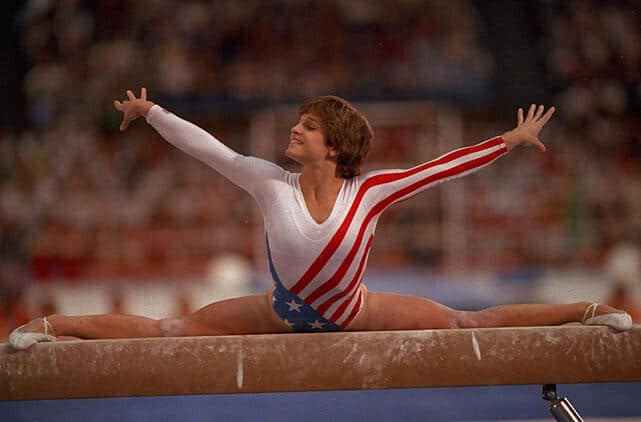
Gymnastics facts tell us that Mary Lou Retton was the first American to win the all-around gold medal at the Olympics. Inspired by Nadia Comăneci’s performance at the 1976 Olympic Games in Los Angeles, Retton took up gymnastics – with great success.
Retton eventually moved to Texas to train with the famed Béla Károlyi, Comăneci’s former coach. Though she had a knee operation just five weeks before the 1984 Summer Olympics, Retton recovered enough to compete.
Mary Lou Retton took home the all-around gold by a margin of 0.05 points. It was a close call! Mary Lou also took home four more medals: the silver team medal, silver on the vault, and two bronzes for the uneven bars and the floor exercise respectively.
The First Gymnasts Practiced Nude
The first Greek athletes trained and competed in the nude. The Greek word gymnazo actually means to train naked. The word gymnastics also has roots in Latin; the Latin phrase gymnasticus means fond of or skilled in bodily exercise. Gymnastics in Ancient Greece resembled what we commonly call track and field, featuring running and jumping, as well as swimming.
Women’s Gymnastics Was Introduced at the 1928 Amsterdam Olympics
One of the surprising gymnastics facts is that the sport introduced in the 1928 Olympics in Amsterdam did not resemble the gymnastics we see today. The events resembled calisthenics and track and field.
The 1st Perfect 10s in Gymnastics Were in 1976

Nadia Comăneci and Nellie Kim both received perfect scores at the 1976 Summer Olympics held in Montreal, Canada. While several men received perfect scores in 1924 at the Paris Olympic Games, this was the first time anyone received a perfect ten in a modern gymnastics competition.
Comăneci, competing for Romania, scored seven perfect scores when she was just 14 years old. That same year, Nellie Kim of the Soviet Union received three perfect 10 scores.
Most of the previous perfect 10s were in rope climbing, an event that no longer exists. This is one of the bizarre gymnastics facts and shows how the early Olympic gymnastics events were very different than the competitions we know today.
The Soviet Union Holds The Most Olympic Medals in Gymnastics
The Soviet Union holds 184 Olympic Medals in gymnastics. This includes both men’s and women’s competitions since 1896. The United States has the second most Olympic medals in gymnastics, with 101.
This brings us to one of the most amazing gymnastics facts: even though the Soviet Union no longer exists, they racked up more medals than any country, even those that continue to compete. Eventually another country will overtake the Soviet Union’s medal count, though at this rate, it could be the 2100 Olympics Games before that happens!
111 American Gymnasts Competed in the 1904 Olympics
The 1904 Summer Olympics were held in St. Louis, Missouri. This was the first time the United States had athletes competing in the gymnastics competitions. Because of the location, many of the athletes were American. Of the 119 gymnasts competing that year, 111 were American. All of the gymnastics events held were for men.
Nadia Comăneci’s Coach Defected to the US During the Cold War
The coach who led Nadia Comăneci to her perfect scores, Béla Károlyi, defected to the United States in 1981 while on a gymnastics tour. Károlyi had numerous disputes with Romanian officials and, along with his wife Marta, decided to seek political asylum in the United States.
Károlyi trained many great women gymnasts during his career, before and after he defected. The famous gymnasts he trained include Comăneci, Mary Lou Retton, Dominique Moceanu, and Kerri Strug.
Kerri Strug Vaulted to Gold with an Injured Ankle in the 1996 Olympics
The 1996 Olympic Games in Atlanta not only celebrated the centennial of the international sports competition, but also became part of sports record books when the Magnificent Seven took the gold in the team gymnastics competition. Gymnastics facts indicate this was the first time the US Women’s Team won the gold medal.
The competition was tight, with Russia expected to win. It all came down to the last event: the vault. On her first vault attempt, Kerri Strug, a Team USA member, injured her ankle. Team USA’s coach, Béla Károlyi, told her it was necessary for her to vault one more time in order to ensure the team would win. Strug completed the vault and clinched a spot in the history books, as Béla Károlyi carried her to the winner’s podium.
The 2004 Olympics Featured Twin Gymnasts that Won Silver and Gold
Gymnastics facts show that the 2004 US Men’s gymnastics team featured twins Paul and Morgan Hamm. Along with their teammates, the Hamm’s won the team silver medal at the Athens Games. In 2004, Paul Hamm won the individual all-around gold medal in gymnastics.
Gymnastics Facts – Facts about Gymnastics Summary
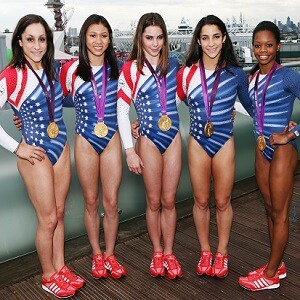 Gymnastics facts indicate that the Ancient Greeks practiced a form of gymnastics we might now more closely associate with track and field. Modern gymnastics was introduced by Friedrich Ludwig Jahn in the late 1700s and was included in the first modern Olympic Games of 1896. There are several forms of gymnastics, with artistic gymnastics being the most recognizable. Both men and women compete in artistic gymnastics at the Olympic level. The Federation of International Gymnastics is charged with creating and regulating the rules of the sport, which has three million participants in the United States alone.
Gymnastics facts indicate that the Ancient Greeks practiced a form of gymnastics we might now more closely associate with track and field. Modern gymnastics was introduced by Friedrich Ludwig Jahn in the late 1700s and was included in the first modern Olympic Games of 1896. There are several forms of gymnastics, with artistic gymnastics being the most recognizable. Both men and women compete in artistic gymnastics at the Olympic level. The Federation of International Gymnastics is charged with creating and regulating the rules of the sport, which has three million participants in the United States alone.
Was this page helpful?
Our commitment to delivering trustworthy and engaging content is at the heart of what we do. Each fact on our site is contributed by real users like you, bringing a wealth of diverse insights and information. To ensure the highest standards of accuracy and reliability, our dedicated editors meticulously review each submission. This process guarantees that the facts we share are not only fascinating but also credible. Trust in our commitment to quality and authenticity as you explore and learn with us.
